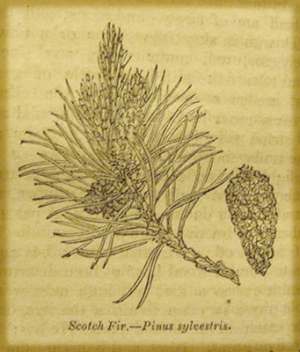
Timber: Common Pine
Although not so durable as oak, pine claims second place among valuable trees. Oak is the main timber for building ships for the sea. Pine is the principal wood for building houses.
It is "The Builders' Timber".
If a carpenter wants a beam of particular strength and durability, he uses oak. If he wants a piece which combines lightness with great length, as for a mast, he uses pine.
There are about twenty-one species of pine. They all bear spines. They are mostly evergreens. The appearance of the tree varies with the species and the situation in which it grows. The timber is harder and more durable if the tree grows in a colder clime or if it grows more slowly.
In peculiar positions it is not unusual to find the northern half of a common pine hard and red, whilst the southern half, though thicker from the pith to the bark, uis white, soft and spongy.
In the peat-bogs of Scotland, the remains of pine trees are abundant. Such is their durability that, where the birch is reduced to a pulp, and the oak cracks into splinters, the heart of the pine remains fresh, and embalmed in its own turpentine, is quite elastic. In England, too, underground beds of pine have been found.
The pines found native to Britain, whether buried or growing,are all of one species: Pinus sylvestris, or wild pine, usually called the Scotch Fir. The timber which it produces is called red deal, or yellow deal, according to the colour. As deals are the form in which it is imported from Norway and the Baltic, the word deal has become the common name for all sorts of pine timber.
With the exception of cedar and larch, Scotch Fir produces better timber than any of the pines. It is good, too, almost in proportion to the slowness of its growth.
When it is cut directly to the centre, or right across the grain, as for the breasts of violins, and the sounding-boards of other musical instruments, it is very beautiful, the little stripes formed by the annual layers being small and delicate, and in perfectly straight lines.
This pine very often (though not in mature trees) contains sap-wood which is a little spongy. The best part is nearest the root, and the roots themselves are excellent for any purpose that their shape and size will allow.
It has been mentioned that pine is best in cold situations. It is also best on light soils, and when planted by nature. On strong clay it grows badly, and the timber is worth little. On rich loams, it grows rapidly, but the timber is inferior, and contains a great deal of sap-wood.
We have counted four or five annual layers of sap upon some trees; more than a dozen on others, and where they have been exposed to the mid-day sun regularly, we have seen the whole southern half little better than sap-wood, while the northern half only contained a layer or two of sap wood at the circumference.
Woodcut:

Pinus sylvestris: Scotch Pine
summarised from "The Library of Entertaining Knowledge - Timber trees" (1829), pub. Charles Knight, Pall Mall.
ND, habitat21
big turbines
small turbines